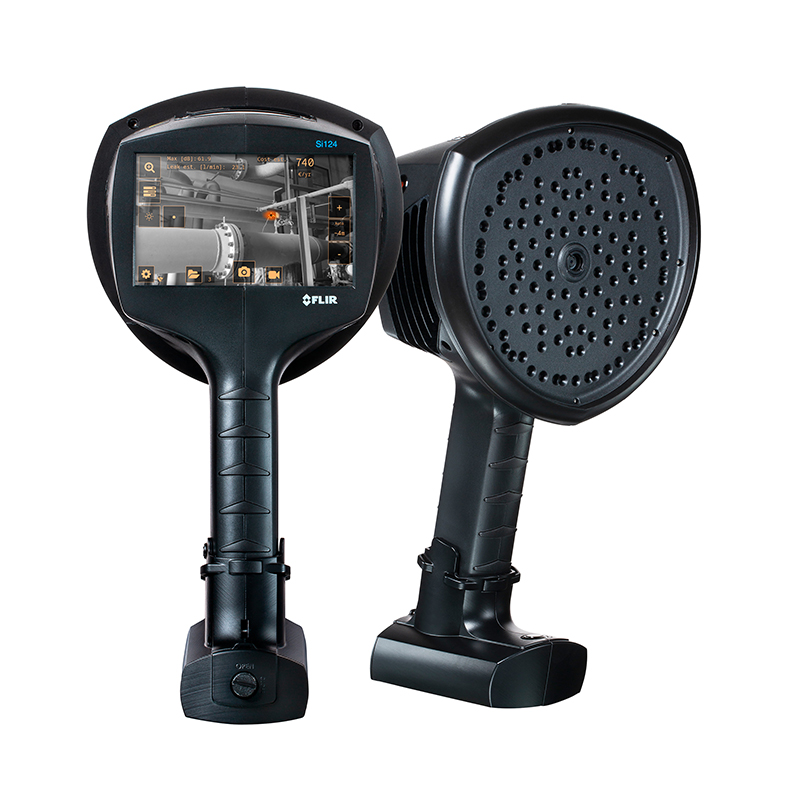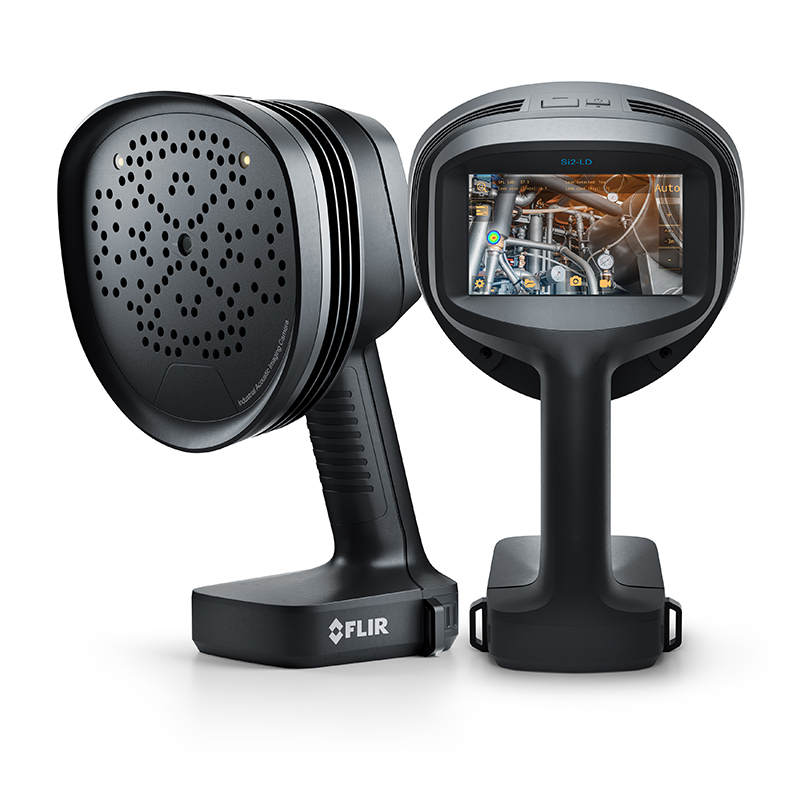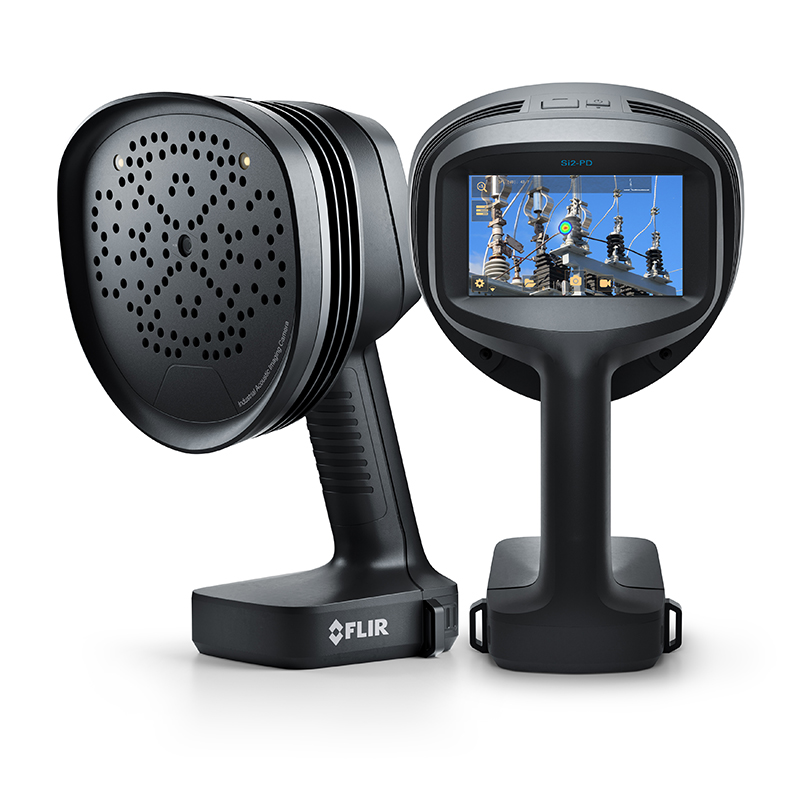
Compressed air leaks account for approximately 30% of manufacturing plants’ electricity consumption. With energy prices subject to volatile global situations, wasting nearly a third of a facility’s compressed air can be extremely costly. Unfortunately, spotting sources of air leaks and quantifying their severity can be difficult and time-consuming. Fear not, for FLIR has developed a series of simple-to-use, handheld acoustic imagers capable of seeing sound, undetectable to the human ear, emitted by compressed air leaks. As a result, FLIR attests that their Si-Series of Industrial Acoustic Imaging Cameras could save businesses up to £29 500 a year.
Quick Links
- Air Leaks: A Costly Problem
- Seeing Sound with the FLIR Si-Series Acoustic Cameras: A Simple Solution
- Seeing Sound Successfully: FLIR Si-Series Case Studies
- Further Information
Air Leaks: A Costly Problem
Typically, industrial facilities lose between 25 and 30% of their compressed air through leaks, misuse, and pressurisation issues, although some leak auditors report that many plants lose over 80%. Within the manufacturing sector energy costs comprise a significant proportion of overhead expenditure; for example, within the paper and pulp industry, powering machinery can account for up to 20% of manufacturing outgoings. Therefore, air leaks contribute to higher energy bills and carbon emissions. As such, they are a significant drain on resources and profitability.[1]
However, compressed air leak detection can be tricky. This is because it is often impossible to see or hear leaks, especially amidst the noise of a manufacturing plant. Moreover, gaining access to industrial equipment for the purposes of inspection requires expensive downtime and places leak auditors/maintenance technicians in harm’s way.
Furthermore, traditional compressed air leak detection is conducted using ultrasonic inspection systems. This requires highly trained specialists using an ultrasonic detector and headphones to analyse equipment and painstakingly trace ultrasonic sound to its source, i.e. the compressed air leak. It’s hard. It’s time-consuming. It’s expensive.
Seeing Sound with the FLIR Si-Series Acoustic Cameras: A Simple Solution
When compressed air escapes through a leak, it generates ultrasonic vibrations. The FLIR Si-Series Industrial Acoustic Imaging Camera detects these wavelengths and converts them into a visual representation plotted onto a digital image. Consequently, maintenance technicians and leak auditors can see quickly and from a safe distance where air leaks are located. Additionally, an integrated leak measurement and cost-analysis function allows teams to understand which leaks are the most severe/costly, enabling effective prioritisation of repairs.
Unlike traditional leak detection methods, the FLIR Si-Series Acoustic Cameras can conduct leak inspections while industrial operations are ongoing, ensuring profitability remains unaffected. Equipped with 124 acoustic microphones, a 12MP digital camera, and helpful analysis functions, the FLIR Si-Series Industrial Acoustic Imaging Camera pinpoints compressed air leaks even in noisy industrial environments. Leaks are indicated clearly on a digital image, eliminating time spent tracing ultrasound. As a result, FLIR’s Si-series makes leak audits ten times quicker than traditional inspections.
In addition to negating the need for expensive downtime and improving inspection efficiency, the FLIR Si-Series Acoustic Camera’s 200m detection distance means technicians/auditors can conduct inspections at a safe distance from dangerous manufacturing machinery. Moreover, a lightweight and ergonomic design makes the FLIR Si-Series Acoustic Imager ideal for comprehensive surveys.
Why Choose a FLIR Si-Series Industrial Acoustic Imaging Camera?
- Reduce Costs, Save Money: Ensure correct air pressure reaches pneumatic equipment and quantify leaks to prioritise repairs, thereby reducing excess utility costs, equipment failures, and downtime.
- Inspect Easily: Lightweight, rugged, and designed for one-handed operation, maintenance technicians can find and assess air leaks quickly, easily, and in real-time. The FLIR Si-Series does not require specialist training to operate and is equipped with Wi-Fi for saving and sharing data.
- Pinpoint Small Air Leaks: Auto Distance and Auto Filtering functions enable technicians to find small air leaks up to ten times quicker compared to traditional methods. The high sensitivity of the FLIR Si-Series means auditors can find leaks as small as 0.016 l/min accurately and safely.
FLIR Si-Series Industrial Acoustic Imaging Cameras Overview
The FLIR Si-Series Industrial Acoustic Imaging Cameras are perfect for compressed air leak detection.
FLIR Si124-LD Plus Industrial Acoustic Imaging Camera
- Specifically designed for compressed air leak detection
- 124 microphones
- 12x improved sensitivity compared to the previous Si124-LD
- Auto-filtering
- Automatic distance input
- View leak rate (l/min or CFM) in real-time
- Quantify leaks down to 0.004 l/min
- Built-in plugin for FLIR Thermal Studio
- Lightweight
- Easy to use
FLIR Si2-LD Industrial Acoustic Imaging Camera
- Specifically designed for compressed air leak detection
- 124 microphones
- 12MP digital camera
- 1280 x 720px, 5-inch colour screen
- Mechanical Fault mode
- Built-in LED lights
- Fleet Management functionality
- Detection distance: 200m
- Automatic tuning
- Measurement and cost analysis function for industrial gases
- Bearing fault analysis
- Built-in data integration
- Integrated GPS
- Seamless integration into GIS platforms
- Detect leaks up to 5x smaller from 4x the distance compared to the Si124-LD Plus
- Quantify leaks down to 0.0016 l/min
- Ideal for maintenance managers, reliability specialists, and NDT technicians
FLIR Si2-Pro Industrial Acoustic Imaging Camera
- Designed for compressed air leak detection and partial discharge (PD) detection
- 124 microphones
- 12MP digital camera
- 8x digital zoom
- 1280 x 720px, 5-inch colour screen
- Mechanical Fault mode
- Built-in LED lights
- Fleet Management functionality
- Detection distance: 200m
- Automatic tuning
- Measurement and cost analysis function for industrial gases
- Bearing fault analysis
- Severity assessment and classification of PD faults
- Recommended actions for addressing PD faults
- Built-in data integration
- Support for Cloud data integration and OTA software updates
- Integrated GPS
- Seamless integration into GIS platforms
- Detect leaks up to 5x smaller from 4x the distance compared to the Si124-LD Plus
- Quantify leaks down to 0.0016 l/min
- Find PD faults 30x smaller than previously possible
- Ideal for professionals working in manufacturing, electrical, power, and utilities industries
Seeing Sound Successfully: FLIR Si-Series Case Studies
Seeing sound with an industrial acoustic imaging camera is a relatively new form of technology and approach to both compressed air leak detection and condition monitoring. Nevertheless, FLIR’s Si-Series of Industrial Acoustic Imaging Cameras have already been adopted by manufacturing facilities to great success. Discover how FLIR’s Si-Series Acoustic Cameras improved safety, efficiency, and profitability at a pharmaceutical plant and at a paper and pulp mill.
FLIR Si Acoustic Imager Improves Productivity at Pharmaceutical Plant
FLIR Si Acoustic Imager Application Scenario: Condition Monitoring in Pulp & Paper Mills
Further Information
For further information on how seeing sound can help you maximise efficiency and profitability or for help and advice regarding FLIR’s Si-Series of Industrial Acoustic Imaging Cameras, please don’t hesitate to contact our Sales team on 01642 931 329 or via our online form.
In the meantime, please find additional pointers on choosing an acoustic camera and more details on the FLIR Si-Series in the articles below.
6 Things to Consider Before Buying an Acoustic Camera
Clearly and Accurately Identify Compressed Air Leaks with FLIR Si-Series Acoustic Imaging Cameras
To view FLIR’s Si-Series of Industrial Acoustic Imaging Cameras, please click here.
See FLIR Si-Series Industrial Acoustic Imaging Cameras
[1]FLIR, Uncovering Compressed Air Leaks in Pulp and Paper Mills with Acoustic Imaging Cameras, last accessed 03 July 2024.





